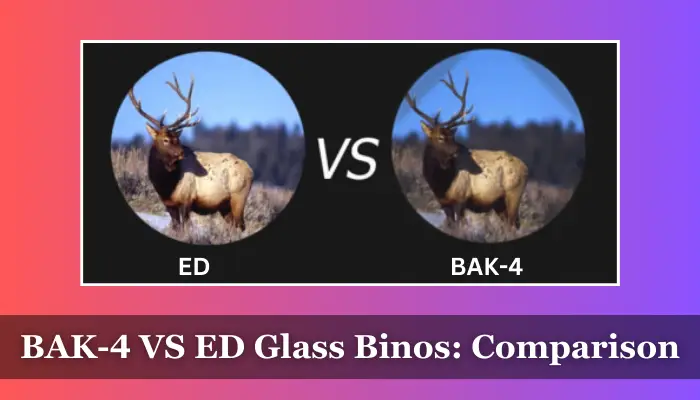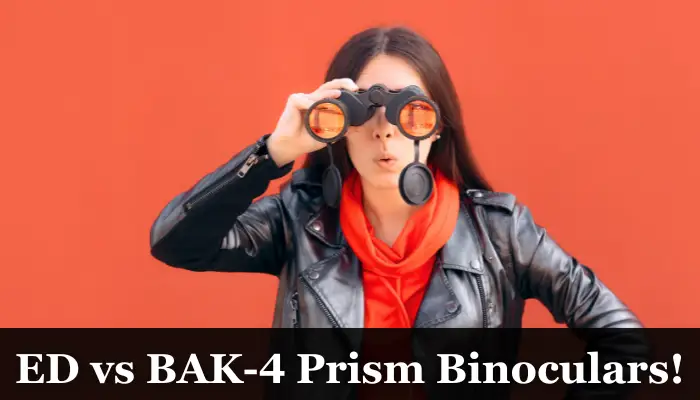This post may contain affiliate links which means I may receive a small commission for purchases made through the links. Learn More
Different binoculars are available in different price ranges. Obviously, the primary thing that decides your buying decision is your budget. But after the budget, the performance, and the features of binoculars are the two most important things that everyone looks at.
When it comes to the optical performance of the binoculars, ED lenses, and BAK-4 prisms are two important components that play a key role. But the question is which one is better, BAK-4 prism or ED lenses?
That’s going to be the discussion, and I am super excited because two things hold an important role in improving optical performance. You will learn the difference between BAK-4 prisms, and ED lenses which will help you understand which one is best for you.
Related Article: Difference Between HD and ED Binoculars
Overview of BAK-4 Prism ED Lenses
In the previous guide, I gave the introduction of BAK-4 prism and explained why it is useful in binoculars and helps in improving the optical performance of the binoculars. Let me give you a brief overview to make a base before I dive into the explanation of the difference between BAK-4 and ED lenses.
The BAK-4 prism is a Porro prism that prevents the loss of light when the image in the form of light comes from the budget lenses to the prism. This prism has a higher refractive index which increases the refraction and ensures that no loss of light happens when the prism reorients the images.
The purpose of using this prism type is to enhance the image brightness and sharpness of the visuals. The brightness without any glares or unnecessary spots takes the optical performance of binoculars to a whole new level.
On the other hand, ED glass which is used to make the ED lenses reduces chromatic aberration and ensures that the user will see edge-to-edge clearer and sharper visuals. ED glass actually has very low dispersion power which does not let the light disperse.
Instead, the ED glasses converge all the light at one point to ensure that the user will see all the light at one point and get perfect clarity from the edges. This was the brief introduction of BAK-4 prism and ED glasses which are used in the binoculars.
Differences Between the ED Glass BAK-4 Binoculars

As I have given you the overview first, it would be a lot easier for you to understand the difference between the BAK-4 and ED lenses.
The BAK-4 prism is used to reduce the loss of light which usually happens when the light from the objective lens touches the prism. When the light is not lost, then maximum light reaches the eyepiece and the user sees brighter visuals.
The BAK-4 prism is usually made with high-density glass material which has a refractive index of 1.56. This material when used in the prism increases the refraction of light and ensures that the light transmission gets maximum.
When more light reaches the eyepiece, then the user sees brighter and sharper visuals. But the ED lenses are totally different from these prisms and their role is also different from the BAK-4 prism.
Apparently, both ED, and BAK-4 prisms increase the quality of visuals, but they do their job in totally different manners. The prism works to make the visuals brighter, but the ED lenses ensure the clarity of the visuals from the edges.
The ED glass has very low dispersion power, and when the light strikes with the prism, then this glass and lenses do their magic. The ED lenses don’t let the light scatter, instead, they make them unite or converge at one focal plane.
The light of different wavelengths converges at one point, so the user sees all the colors of the light clearly. There remains no scattered light which could make the corner to edge blurry. This is how the binoculars with ED lenses reduce the chromatic aberration.
Key Takeaway: The binoculars with BAK-4 prism produce brighter and sharper visuals. They perform better in lowlight conditions because no loss of light happens, but the ED binoculars reduce or eliminate the chromatic aberration, and ensure that the users will get edge-to-edge clarity visuals.
ED Glass Binoculars vs BAK-4 Prism Binoculars: Comparison Table
In the section above, you have learned the basic differences and functionality of both ED glass and BAK-4 prism binoculars. But I am not letting you: instead, you are going to get a detailed comparison table that will help you understand the differences between these two binoculars.
| ED Glass Binoculars | BAK-4 Prism Binoculars |
| Minimizes chromatic aberration | Brighter images |
| Enhanced color reproduction | Higher refractive index |
| Superior image quality | Better light transmission |
| Excellent color accuracy | Versatile for various activities |
| Higher cost | More affordable option |
| Decent performance in lowlight conditions | Ideal performance in lowlight conditions |
| Converges light at one focal point | Reduce the loss of light |
| More lifelike and sharper visuals | Slightly dull visuals but more brighter |
Are ED Glass Binoculars Better Than BAK-4 Binoculars?
It depends on individual preferences and budget, I personally consider ED glass binoculars a superior option to BAK-4 prism binos as they offer ideal optical performance with edge-to-edge clarity.
The brightness of the visuals is important but, the clarity in the visuals is key when we see the object which is very far away from us. In the daytime, you will get brighter visuals with almost all the binoculars present in the world.
The reason is that more light is present in the surroundings in the daytime, so the objective lens captures more light and gives you brighter visuals. But BAK-4 prism binoculars are better for low light conditions when the surrounding light is insufficient.
So, with BAK-4 prism binoculars, you will see optimally brighter visuals in lowlight conditions. The light that the objective lens will capture won’t get lost which will make the overall visuals brighter.
But when it comes to ED glass binoculars, I am slightly in favor of them. The reason is that they provide visuals that are free from the sort of distortion, and color imbalance. They are perfectly clear and sharper.
To be honest, it is always frustrating when the binoculars offer visuals that are not clear at the edges. However, the ED binoculars provide better edge-to-edge clarity and improve the overall optical performance.
The second thing is that the ED glass binoculars also offer optimal performance in lowlight conditions. Although they are not ideal, they still provide you with enough clarity and brightness in the visuals.
This is why I consider ED glass binoculars to be the superior option. However, you should also keep in mind that ED glass binoculars are expensive due to their ideal optical performance, and you will need a handsome budget to buy them.
If you are riding on a tight budget, don’t make the mistake of choosing the ED glass binos and putting an extra burden on your pocket. Instead, you should consider the BAK-4 prism and enjoy decent visual performance.
Conclusion
I hope that I have provided you with complete information about these two ED and BAK-4 prism binoculars. In short, I recommend ED glass binos as they offer better edge-to-edge clarity. However, if you have tight money, then going with BAK-4 prism binoculars would be a wise decision. Both are excellent in their own ways.

I’m a passionate outdoor activist who has got special love for optics. The school studies in optical mechanics and the travelling experience has made me an expert in optics like binoculars, scopes, and other devices. Stay connected with us for in-depth knowledge!

